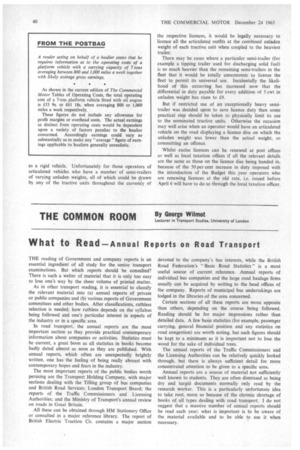Relicensing Essentials Examined
Page 41

Page 42

If you've noticed an error in this article please click here to report it so we can fix it.
common to many of the forms used in exporting could be inserted on all of them after being set down once only.
The system evolved is now explained in the booklet just published. It is claimed that it is consistent with European developments and can be operated with inexpensive, simple and well-tried office machinery. The most commonly used export forms have been recommended for inclusion in this system. It is hoped that all concerned with exporting will examine carefully the advantages which this system offers and will expand this " aligned series" by adapting their own internal forms where ever possible. A number of countries in Europe are .adopting similar systems based on a standard layout key devised by the Economic Commission for Europe with which the British aligned series is compatible except in small detail.
One Typing Operation
Because these newly designed export documents can be completed in one typing operation the elimination of much repetitive typing and checking also reduces the possibility of error. Moreover the forms are being re-designed on A4 international size paper so that the spaces for the entry details common to all or some of the forms fall in the same relative position on each form. All of these forms can be completed from a master document and any details not required on any particular form can be suppressed.
The export documents initially recommended for inclusion in the aligned series are:
I, Rill of Lading; 2, Customs Entry Form XS 29: 3, Exchange Control Form CD 6; 4, United Kingdom Certificates of Origin (issued by Chambers of Commerce); 5. Certificates of Insurance (issued by Lloyd's and the Institute of London Underwriters): 6, Port of London Authority Port Rates Form; 7, Port of London Authority Shipping Note; 8, Mersey Docks and Harbour Board Dock Rates and Town Dues Bill.
In addition to giving detailed explanations of the system, examples of the forms used are included in this booklet which is obtainable free from the London or Regional offices of the Board of Trade.
RENEWAL OF EXCISE LICENCES Although the annual renewal of excise licences for goods vehicles is no longer limited to January 1 each year there still remains a substantial proportion of such vehicles which are in fact re-licensed annually on that date. Although the staggering of re-licensing throughout the year would seemingly provide the corresponding advantage of staggering payments, in some instances operators have found that the relatively spasmodic occurrence of the separate date for re-licensing tied to the date of original purchase could, and in some cases has, led to omission to re-licence due to oversight.
To avoid such a possibility some operators prefer to continue to re-licence either the whole fleet on January 1 or, say, a quarter of the fleet on four fixed dates throughout the year. Accordingly a table of goods vehicle excise duties as at present apply is given on this page. Readers are reminded that the rate of duty now payable was increased by 50 per cent with the introduction of the Budget last April. Accordingly those who are re-licensing for the first time since before the date of the increase (April 6) should note that the duty now payable will not be the amount shown on the existing licence but as shown in the table below. Failure to do this would of course result in delay arising from the local taxation office having to return the application because insufficient duty had been remitted.
Regarding the excise duties shown in the table, when a vehicle is used with a trailer, such rates relate to a rigid vehicle towing a draw-bar trailer. For the purpose of excise duties the combined unladen weight of tractive unit and semi-trailer constitute a " vehicle " in the same sense as a rigid vehicle. Unfortunately for those operators of articulated vehicles who have a number of semi-trailers of varying unladen weights, all of which could be drawn by any of the tractive units throughout the currency of
the respective licences, it would be legally necessary to licence all the articulated outfits at the combined unladen weight of each tractive unit when coupled to the heaviest trailer.
There may be cases where a particular semi-trailer (for example a tipping trailer used for discharging solid fuel) is so much heavier than the remaining semi-trailers in the fleet that it would be totally uneconomic to license the fleet to permit its universal use. Incidentally the likelihood of this occurring has increased now that the differential in duty payable for every addition of 5 cwt in unladen weight has risen to O.
But if restricted use of an exceptionally heavy semitrailer was decided upon to save licence duty then some practical step should be taken to physically limit its use to the nominated tractive units. Otherwise the occasion may well arise when an operator would have an articulated vehicle on the road displaying a licence disc on which the unladen weight was lower than the actual weight, so committing an offence.
Whilst excise licences can be renewed at post offices as well as local taxation offices if all the relevant details are the same as those on the licence disc being handed in, because of the 50 per cent increase in duty imposed with the introduction of the Budget this year operators who are renewing licences at the old rate, i.e. issued before April 6 will have to do so through the local taxation officer.












































































